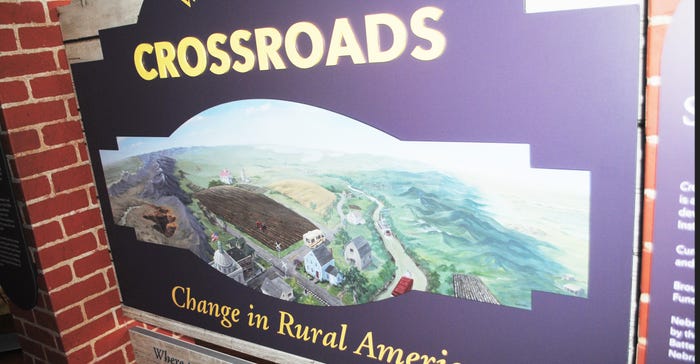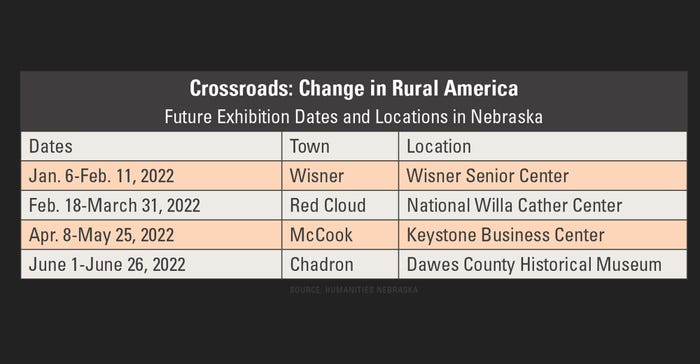
There is something special about small towns and rural life. The Museum on Main Street, in partnership with the Smithsonian Institution Traveling Exhibition Service and state humanities councils, has brought a special exhibit, “Crossroads: Change in Rural America,” to rural Nebraskans at sites around the state into 2022.
This unique, interactive exhibit focuses on those special things that make rural life, agriculture and small towns so crucial to the cultural fabric of the country.
This massive exhibit includes interactive modules of art, photography, artifacts and displays that include audio rural sounds and testimony from rural Americans, discussing the challenges, rewards and benefits of rural life in the past and today.
“Crossroads” features a small-town platform to open debate and discussions of what the future holds for rural life and small towns, and the role agriculture plays in that future.
The exhibit began its Nebraska tour in Kimball on Sept. 11. It opened in Tecumseh on Oct. 6 and is in Falls City at the Stalder Gallery/Falls City Library and Art Center from Nov. 19 to Dec. 27. It will then be traveling to other locations in Nebraska into 2022, including Wisner, Red Cloud, McCook and Chadron.
Perfect location
In Tecumseh, the Johnson County Historical Society and Johnson County Museum served as hosts for the exhibit, planning special events around the exhibit’s opening in the community. The museum is located in the historic Cornerstone Building, built in 1890 on the impressive courthouse square across the street from the Johnson County Courthouse.
“Johnson County is a rural community that fits the profile that the ‘Crossroads’ exhibit epitomizes,” says Sarah Williamson, president of the Johnson County Historical Society. “Our most recent addition to the museum exhibits a tribute to agriculture and transportation of the early to mid-1900s. This depicts the era that the ‘Crossroads’ exhibit mirrors.”
Williamson says that the goal all along is to make visitors and local residents aware of the fact that while rural populations in general have been declining, and the agribusiness model has changed, the industry remains vibrant and vital to the local economy.
“While we all long for the good old days, our heritage and culture ensure that we will successfully adapt and move forward,” she adds.

The “Crossroads” exhibit offers small towns a chance to look at their own paths, to highlight changes that have affected their fortunes over the past 100 years. It also prompts discussions about how America’s rural population, once the majority, has now become the minority in the country, and how that plays out in our communities today.
The exhibit in Tecumseh has stirred those discussions. “Residents learned on multiple levels,” Williamson says. “Although living in an agriculture community, residents were amazed and intrigued to learn of the advances in technology and agricultural methods. Some believed that no-till planting, for instance, was a relatively new technique. That is until one farmer said he began to no-till in 1972. That’s 50 years ago.”
Tecumseh heritage
Williamson talks about one of the early businesses in the community, a cream- and egg-buying station that evolved into Swanson Co., famous for inventing frozen TV dinners, then a division of Campbell soup, and currently operating as Smart Chicken.
“Smart Chicken is a pioneer in organic chicken production and processing, as well as a pioneer in the air-chilled processing method,” she says. “They are on track to raise and process 500,000 chickens annually.” That tradition, which is brought forward to today, is just one example that steeps the town of Tecumseh into the history of agriculture in the state.
“One of the most gratifying experiences is the ‘Stories: YES’ aspect of the ‘Crossroads,’” Williamson says, “because the program offered the resources and framework for Johnson County Central Schools students to interview members of the agriculture community and produce a video presentation. The students gained hands-on knowledge of agriculture and an appreciation of the industry.”
She notes that the process lasted more than a year and had an impact of bridging generational gaps. The video will now be available on the Smithsonian website.
Monumental task
Hosting such a massive and monumental exhibit is no cakewalk. The museum was notified in January 2020 that they had been selected by Humanities Nebraska to host the Smithsonian exhibit.
“We were extremely honored to be one of the seven museums in Nebraska to be selected,” Williamson says. “The pandemic necessitated that the group of seven museum personnel, along with those from Humanities Nebraska and the Smithsonian, communicate via Zoom. There were four meetings, each lasting two hours, to learn about the exhibit and share ideas. The process evolved into each of the seven museums developing a unique adaptation tailored to its community.”
Kimball was the first Nebraska site in the exhibit tour, so representatives from all seven museums and Humanities Nebraska gained hands-on knowledge of display assembly by visiting the exhibit at Kimball.
“Smithsonian representatives were on-site to instruct and oversee the process,” Williamson says. “Everything about the program is first class. We have been supported every step of the way during the two-year period of planning and execution.”
That support has included everything from the actual traveling exhibit, marketing and docent training.
Learn more online at humanitiesnebraska.org.
About the Author(s)
You May Also Like






